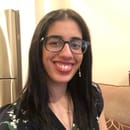After a great study abroad experience in London, I was ready to start the new semester back in New York with my friends. It was crazy to imagine that half of my junior year was gone in so little time. Starting the new semester meant starting new classes, meeting new professors and getting to know new people in my classes. The semester has turned out to be a challenging but great one so far. One challenge that used to stress me out was explaining my deafness to my professors along with the accommodations that I need to help me in class. This fear is due to having teachers in the past who weren’t willing to work with me, which led to frustrating experiences in school. Fortunately, I had great Teachers for the Deaf who taught me to stand up for my rights and myself as a student. Thanks to those lessons, I am able to communicate clearly with my professors. This semester, all professors have been open to suggestions and working with me so that way I can have a better experience in their respective classes. Little did I know that a big change would be on the horizon.
In the news, the outbreak of COVID-19 was becoming a reality when cases appeared in the United States. There were even cases that were showing up in New York, which was where I study for college. I was aware that this could affect my semester, but I was busy preparing for my midterms. I saw reports of school districts along with colleges closing their campuses due to the outbreak being declared as a pandemic. I soon received an email from the school saying that on March 11th, all classes would be moving to a virtual platform until further notice. I was scared and I immediately forwarded the information to my parents. My parents are my two biggest supporters, and I knew I could count on them to help me understand what this information meant. They had been watching the news and all of us agreed that I should go back home to New Jersey. Luckily, we were able to move me out in time when the school declared that they would be closing the dorms.
I have taken a couple of online classes in the past, but this new format with Zoom is an entirely new concept for me. Honestly, I was not too stoked about this change because this meant more challenges. One concern I had was how the quality was going to be with using Zoom. Usually I would have the professor wear my FM unit in class, but this was a different situation. I found that I could use my FM along with an audio cable to use as headphones to hear what my professor was saying. I also have good headphones that cover my ears, which means the small microphones in my cochlear implants can pick up the sounds.
Another concern was how was I going to determine who was talking in the class? I rely on lipreading, which means I need to be able to see people’s faces when they are speaking. I was aware that there was a function on Zoom where you could turn off your webcam, which was a concern for me. I asked my specialist with the Moses Center to figure out how I can ask my professors and peers to turn their cameras on when speaking, without making it awkward. She helped me draft an email and also spoke with my professors on my behalf. Thanks to her, my professors were understanding and told me to let them know if there was anything else they could do to help me. All of them understood that this was a new thing for me and they were thankfully very patient with me while I navigated through this change.
Some of my professors decided to pre-record their lectures and share them as videos, which was another worry of mine. In the past I have had professors show videos in class, but I would say about 90% of the time, there would be no closed captions. I pointed out this issue to my professor, while internally afraid that I would be embarrassed about this. It was the opposite, as my professor told me where I could find the closed captions on the video while also having access to the transcripts. In some of my other classes, my professors had us watch videos as a supplement to the lectures or group discussions. If the video didn’t have closed captions, they asked me to let them know, further making it clear they understood if I couldn’t fully understand videos at-hand. Videos have become part of the new curriculum, which is still a gray area for me. While it is easy for professors to use videos, it’s still an issue that many videos don’t have closed captions, which leaves me in the dark.
There could be negatives with this new curriculum, but so far I have been doing pretty well with this new situation. It has also helped me in interacting with my classmates more than I did back on campus. One thing I always struggle with is making friends, but this semester I saw myself trying to push out of my comfort zone. I have been making connections in my classes, but I was bummed with the sudden changes that have happened recently. Fortunately with Zoom, I am still able to see my friends’ faces and interact with them. Additionally, I have been contributing more to group discussions. I don’t know why, but maybe it’s because I can see almost everyone’s faces clearly in front of me and that I don’t have to worry about not speaking clearly. As a deaf student, I was afraid that I was going to start failing my classes due to this new change. However, working with my professors and specialist to help ease the transition to the new curriculum has been beneficial. Hopefully these times will get easier and students can return back to their schools for the next school year. With that still being unknown, the best thing to do is stay home, stay safe and practice social distancing.



